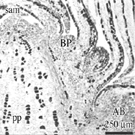Seasonal Variation of Organogenetic Activity and Reserves Allocation in the Shoot Apex of Pinus pinaster Ait.

SAM accumulates reserves for growth potential
In common with many woody species, Pinus pinaster exhibits clear differences between juvenile and adult growth patterns. In male plants the transition from juvenile to adult occurs after 3 years and in females after 5 years. Transition is characterised by several features, of which Marie-Noelle Jordy (Vandoeuvre, France, pp. 25-37) has focussed on the activity of the shoot apical meristem (SAM). In juvenile plants, there are two peaks of shoot growth, one in April and one in October although only the spring peak is associated with an increase in meristem size. Similar spring and autumn peaks occur in the organogenetic potential of the SAM, as indicated by the establishment and emergence of bud primordia. By contrast the SAMs of adult plants exhibit growth and organogenetic activity from spring through to autumn with a peak in July. Within this adult pattern, sub-patterns are seen: leaf primordia are established throughout the growing season, with shoot primordia in the summer; reproductive structures are established in summer in male plants and in autumn in female plants. So, what is it that controls these different growth patterns? At present there is no clear answer to this question. However, the author has demonstrated a number of seasonal variations in shoot biochemistry. RNA accumulation is associated with the autumn (but not with the spring) peak of activity in the juvenile SAM and with the summer growth peak in the adult SAM. In both juvenile and adult plants, higher concentrations of starch and tannins are correlated with the peaks of growth activity whereas lipids are laid down in autumn, retained in winter and metabolised during spring and summer. In both juvenile and adult plants there is thus a complex network of morphological and biochemical changes and it will be very interesting to elucidate the environmental and developmental signals that regulate these changes.
University of Exeter, UK
j.a.bryant{at}exeter.ac.uk